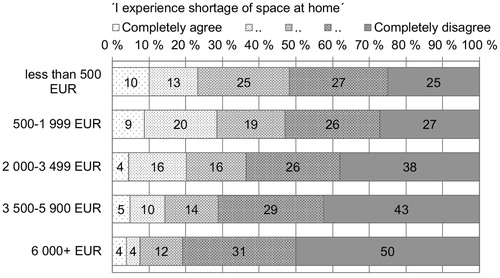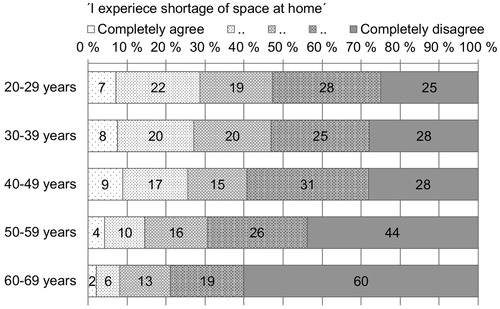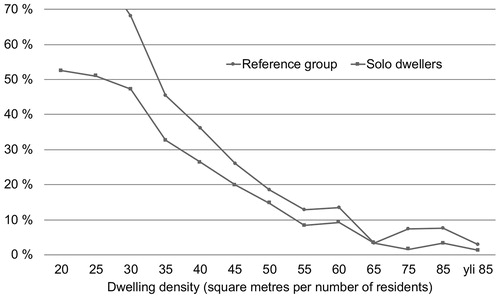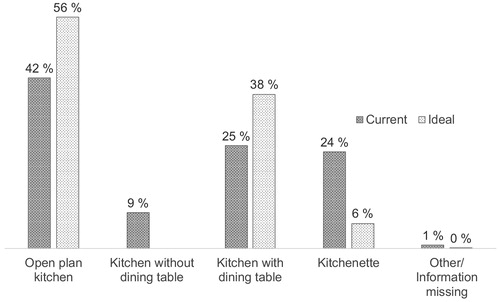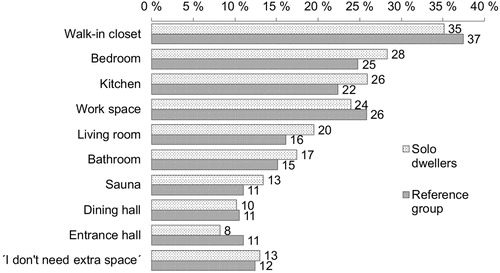Abstract
Solo dwellers’ housing issues have received little attention in housing studies. This article addresses their domestic spatial needs in the context of the Helsinki Metropolitan Area (HMA) where dwelling sizes have decreased rapidly. A critical stance towards the trend of constructing small one-room apartments and related norm deregulation is based on the notion that dwellings should be at least 50 m2 and contain more than one room in order to overcome the shortage of space experienced by solo dwellers (N = 1453). Emphasizing the perspective of housing design, the findings provide insights into floor plan design by focussing on apartment types and sizes in relation to kitchen types and the experienced shortage of space. All in all, the article demonstrates that solo dwellers’ domestic spatial needs are more diverse than expected based on their household size and related public discussion on urban housing.
Introduction
Rapidly decreasing household sizes have introduced a new level to urban housing issues in developed societies (Hall & Pfeiffer, Citation2000; Thorns, Citation2002). In 2017, one third of all households in the EU were one-person households. In the Nordic countries, these figures are even higher (Eurostat, Citation2018). In Finland, the medium size household unit fell under two in 2018 thus reflecting the continuous rise of solo-living (OSF, Citation2019) Despite this sizeable number, solo dwellers’ housing issues and domestic spatial needs have received little attention in housing studies. Moreover, studies relevant to the practices of housing design and related policy issues barely exist.
As a reflection of this lack of research in the above-mentioned fields of inquiry, terminology referring to one-person households has been unestablished; this has been observed by Jamieson et al. (Citation2009), who call for an analytical distinction between solo-living, singles, and solos as the ‘categories of residence arrangements, legal marital status and partnership status’, respectively. Thus, in order to stress the aspects of housing, residential arrangements, and related design approach, the terms applied in this article are solo-living, followed by solo dweller which are preferred over ‘lone persons, ‘lone-person households’ (Wulff et al., Citation2004), ‘lone dwellers’, and ‘singleton’ (Ronald et al., Citation2018).
While the literature on solo dwellers’ home-related social life provides some hints on their spatial needs (e.g. Jamieson & Simpson, Citation2013; Klinenberg, Citation2012), the characteristics of dwelling space have remained untouched. Without this knowledge, there is a risk that housing stock is developed based on the stereotypical and possibly outdated perceptions of solo-living (see Jamieson & Simpson, Citation2013). For instance, coupling small households with small dwellings may not be valid (Williams, Citation2009).
This article addresses the following research question: how much space and what type of domestic space is needed by solo dwellers? The objective is to provide knowledge for the actors steering housing supply, that is, architects, planners, developers, and policy makers (Gao et al., Citation2013; see also Boumeester, Citation2011) as well as to develop field-specific methods for housing studies. The findings are discussed in a country-specific context, which renders them meaningful as is typical in housing issues and design disciplines (Gao et al., Citation2013; Özsoy & Gökmen, Citation2018; Paadam et al., Citation2016;).
In order to better understand what kind of dwellings solo dwellers would like to have, this paper explores their perception towards fixed dwelling features (see Coolen & Ozaki, Citation2004) such as apartment types and sizes as well as kitchen types connected with floor plan design (i.e. layouts) in the case of similar apartment types1 (Tervo & Lilius, Citation2017). A need to study floor plans is emphasized by the notion that they are rarely discussed in detail (Gao et al., Citation2013, p. 430). The experienced shortage of space, examined in relation to dwelling features and floor plans, is considered an important issue as dwelling sizes are decreasing in urban centres. Furthermore, previous studies have not touched on the shortage of space experienced by solo dwellers. This may be due to the applied norm in Finland and other countries in which the household is considered to be living in an overcrowded dwelling in the case of the number of household members exceeding the number of rooms (OSF, Citation2018a). This means that any apartment is considered to be sufficiently spacious for a solo dweller.
The data has been collected from the Helsinki Metropolitan Area (HMA) in Finland2 (n = 1453). In this area, the average dwelling size has decreased from 86.6 to 60.2 m2 between 2007 and 2017, thus reflecting the increasing share of small apartments (Helsingin seudun aluesarjat, Citation2017; Rauniomaa, Citation2018). This trend has been hotly debated in Finnish media with the key questions seemingly being the feasibility of continuing to build one-room apartments and the lack of affordable housing (Kortelainen, Citation2017; Oksanen, Citation2018; Pajuriutta, Citation2018; Salomaa, Citation2018). Indeed, decreasing apartment size to the point of minimum space standards should be addressed since the appropriate amount of dwelling space and residential satisfaction are interrelated (Baker, Citation2008; Dekker et al., Citation2011; Lu, Citation1999). A need to study an adequate dwelling space is highlighted by the extensive list of domestic activities linked with the amount of space (see Crosby, Citation2015; Roberts-Hughes, Citation2011).
This article is organized as follows. The next section reviews the literature on solo dwellers’ domestic spatial needs, emphasizing the type of knowledge needed in design processes. The third section discusses space standards, regulations, and their implications for housing design. The fourth section presents the data and methods. The findings are presented in two sections: Apartment Types and Sizes, and Insights into Floor Plans. The article concludes with notions and recommendations for the successful future of urban solo-living and housing studies.
Literature on solo dwellers’ domestic spatial needs
The rise of solo-living has been observed by several studies, yet the literature on solo dwellers’ housing arrangements and domestic spatial needs is surprisingly disparate. This notion is highlighted when the literature is reviewed based on its relevance to housing design practices. Sometimes the scale of inquiry is not sufficiently detailed, as is the case with studies focussing on the changing demographics in urban areas (Buzar et al., Citation2005; Hall et al., Citation1997). This is expected to be caused by the nature of data as the statistics are unable to reflect the combination of household features and dwelling features (Boumeester, Citation2011; see also Hasu et al., Citation2017).
Another challenge in the study of solo dweller’s housing issues results the analyses merging the responses of different household types. For instance, in a study about urban density and crowding, Chan (Citation1999, p. 112) showed that the residents frequently attained ‘the state of privacy as they expected’ because they were able to control the use of space in their home environments. However, should privacy not be regarded as an inherent dimension of solo-living?
Moreover, the heterogeneity of one-person households (e.g. Jamieson & Simpson, Citation2013; Jamieson et al., Citation2009; Klinenberg, Citation2012) has not necessarily been considered. An example of this is provided by the Residents’ Barometer (Strandell, Citation2017) which combines the responses of solo dwellers up to 65 years old living in those Finnish municipalities containing more than 10,000 inhabitants. Here, the results discussing the quality of residential environments are disconnected from the respondents’ age-related life situations as well as the characteristics of the location and urban structure which are all relevant aspects for housing design practices.
Indeed, few studies explore solo dwellers’ domestic spatial needs. For example, Wulff et al. (Citation2004) have discussed the reasons behind the increasing housing density of one-person households in Australia. Whereas the emotional attachment to the home and neighbourhood may explain the reasons elderly solo dwellers choose to stay in spacious dwellings, similar dwellings may be chosen by middle-aged divorcees due to the spatial needs of their children who have two homes, or because of the hope of eventually finding a new partner. Based on the data from interviewees living alone at the ages of 25–44 in the UK, Jamieson & Simpson (Citation2013) have noted the need to have a spare bedroom in order to maintain and develop meaningful relationships. In a recent study about young unmarried Japanese singles, Ronald et al. (Citation2018) have found that visits from friends, parents, and other family members were unusual in units less than 29 m2, and the social interaction tended to occur in third places.
Three studies, all connected to the HMA, cast light on solo dwellers’ spatial needs in terms of apartment types and sizes. In the first study, Silvennoinen & Hirvonen (Citation2002) found that solo dwellers (n = 197) who were unsatisfied with their apartments had on average one-room apartments sized 35 m2, whereas an adequate apartments size was on average 55 m2. However, they also noted that defining an adequate amount of living space is a subjective matter. In the second study, Backman (Citation2015) focussed on solo dwellers aged 25 to 74 years old living in the Capital City of Helsinki (n = 1088). The study stressed the characteristics of residential areas. In terms of apartment types and sizes, a majority of the respondents preferred apartments 40 to 59 m2 equalling two-room apartments. Nevertheless, almost 30% preferred apartments with 60 to 79 m2 equivalent to a three-room apartment, whereas a one-room apartment sized under 40 m2 was rarely preferred. In the third study, based on interviews of solo dwellers aged 30 to 64 years old living in the Capital City of Helsinki (n = 68), Tervo & Lilius (Citation2017) discussed apartment types and floor plans. In order to identify the possible shortcomings of the current dwelling spaces, the interviewees were asked to describe what changes they would make to their homes if provided with an extra ten square metres. The findings signified the unpopularity of one-room apartments as the majority (18/24) of those currently with this apartment type would rather change their homes into a two-room apartment instead of having a spacious one-room apartment. Moreover, the findings also demonstrated that the kitchen type is a key element in an ideal floor plan in similar apartments types, and many would like to have a better kitchen sufficiently large to accommodate a dining table. The impact of a kitchen solution increases as the apartment size decreases, which is often the case with solo dwellers living in dense urban areas.
Space standards and regulations
The country-specific space standards and regulations steer the construction of new dwellings. While most European countries have space standards that define the ‘functional requirements of a dwelling’ (Williams, Citation2009, p. S90), the country specific differences ought to be recognized. According to the National Building Code of Finland, applied in private as well as in publicly subsidized housing, the minimum net area for an apartment is 20 m2. The smallest possible size for a habitable room is seven square metres (Ministry of the Environment of Finland, Citation2017). The building regulations have been criticized by Gibler & Tyvimaa (Citation2014, pp. 370–371), who have identified four consumer segments with specific housing preferences. According to these authors, space standards hinder the fulfilment of consumers, such as ‘Funlovers’, who are mostly singles and couples who ‘view their homes simply as shelter’, because they prevent the construction of micro apartments. Simultaneously, it should be noted that small and affordable are not necessarily interconnected as pointed out by Williams (Citation2009, p. S90), who argues that the absence of minimum space standards supports the developers’ interests to decrease dwelling sizes without reducing their prices.
An apartment block, constructed in the City of Vantaa in 2017, is a rare example of Finnish minimum housing and norm deregulation. Enabled by special permission, the building contains 68 micro apartments sized 15.5 m2. The units are supplemented with a ground floor recreational space, and a top floor sauna with an adjoining terrace (SATO, Citation2017). In addition to the apartment sizes, the building is also at the edge of another institutional boundary as the monthly rent of 500 euros almost equals the maximum housing cost of 492 euros that is considered when calculating the housing allowance in this location in 2017 (Finnish Social Services, Citation2018). Affordability has many faces as indicated the rent per square metre that is 32.3 euros. In comparison, the average rent for a one-room apartment in the City of Vantaa in 2017 was 18.6 euros per square metres (City of Vantaa, Citation2018). Although these tiny apartments raise questions about the adequacy of the dwelling space, nevertheless, it is important to acknowledge that the built-in furniture, detailed design solutions, and extensive room height increase their usability and the overall quality of space.
Currently, the Finnish general housing allowance sets only the limit for the maximum housing cost linked with the household size in four municipality categories (Finnish Social Services, Citation2018). Although this system favours the construction of small apartments with a relatively high rent per square metre, it has advantages in relation to housing benefits based on the number of rooms. For instance, in the UK, a spare room cuts the allowance by 15%, and two or more rooms by 25% (Ministry of Housing, Communities and Local Government, Citation2018). Morgan & Cruickshank (Citation2014) state that the majority of households who lose housing benefits because of the ‘Bedroom tax’, inhabit small dwellings in which the extra bedroom balances the lack of internal space. As many of the dwellings would not be suitable for a larger number of residents, it is argued that ‘the relationship between the number of inhabitants and the number of bedrooms has been shown to be a poor metric use (Morgan & Cruickshank, Citation2014, p. 722)’. In addition, Morgan & Cruickshank (Citation2014) state that defining the appropriate domestic space is complicated due to the spatial qualities of dwellings and the subjective experiences of residents. While these notions call for a deeper understanding of the architectural and psychological qualities of dwelling space, they also point out that the way of measuring an adequate amount of space and policy principles are interrelated.
Data and method
The data was gathered using an Internet-based questionnaire published via the leading Finnish newspaper, Helsingin Sanomat.3 In total, over 13,000 (n = 13,381) people, including 3071 solo dwellers living in Finland, answered the survey in October 2016. In this article, we use the data concerning the spatial needs and experienced shortage of space. Other questions in the survey focussed on everyday life and routines in home environments. A similar data collection method has been previously used in studies concerning loneliness in Finland (Junttila et al., Citation2016; Kontula & Saari, Citation2016).
The findings are based on a sample that covers solo respondents aged 20 to 69 years old in the HMA (n = 1453). Although the data is not a representative sample of this population, it allows for an examination of the discrepancies between the current and desired dwelling features in order to gain knowledge about housing demand (see Boumeester, Citation2011). For the sake of transparency, the sample was compared with the HMA population at the time of the survey being conducted. In the data, the following groups are over-represented: women (survey 77% vs population 51%), those living in the City of Helsinki (survey 76% vs 65%), and those under 40 years old (survey 53% vs 44%). In contrast, the following groups are under-represented: inhabitants of the cities of Espoo and Kauniainen (survey 10% vs population 18%), and the City of Vantaa (survey 14% vs population 17%) (Helsingin seudun aluesarjat, Citation2017). The data has been translated from Finnish into English.
The background information included age, gender, household size, income after taxes, and state subsidies as well as the current housing situation (dwelling type, apartment type, apartment size, and kitchen type). The findings are based on four questions and one claim sentence, which considered the ideal number of habitable rooms (i.e. apartment type) and apartment size needed in correspondence to respondents’ current homes, favored kitchen type, use of ten extra square metres in relation to the respondents’ current home, and the experience of shortage of space. The survey questions are presented in the Appendix.
In the analysis, the background information was compared with dwelling features (apartment type, apartment size and kitchen type), the use of ten extra square metres, and the experienced shortage of space (agree completely or almost completely with the statement ‘I experience a shortage of space in my home’). Since a small number of solo respondents stated that their ideal apartment size is considerably larger than their current apartment, the findings also present the median values. Overall, the ideal apartment sizes are in line with income level, thus it is expected that the responses are based on the respondents’ realistic economic possibilities as intended. In order to define the specific characteristics of solo-living, some findings were set against the responses of other household types represented by the respondents aged 20 to 69 years old in the HMA (n = 4401). These respondents are later referred to as the ‘reference group’.
It should be noted that the data is about fixed dwelling features and thus this article does not consider location and other environment features, or housing related values and attitudes steering housing preferences (Hasu, Citation2018; Ilmonen, Citation2016) and lifestyles (Hasu et al., Citation2017; Jansen, Citation2012). However, we do argue the importance of focussing on apartments and related features in a situation in which housing stock is insufficient, increasing the construction of small apartments is taken for granted, and the decisions mirroring the changing demographics are characterized by a noticeable ignorance of residents’ perspective.
Apartment types and sizes
The majority of solo respondents (85%) live in apartments with one or two rooms in which the kitchen is not counted as a room. A comparison between the current and ideal apartment types reveals two distinct gaps. First, one-room apartments are inhabited by 42%, but perceived as ideal by only 3%. Second, three-room apartments are inhabited by 12%, and perceived as an ideal apartment type by 44% (). In an optimal situation, 48% would like to have one extra room, and 17% even two extra rooms. On the other hand, 25% of the solo respondents already live in their ideal apartment types with a majority (57%) of these respondents residing in two-room apartments. Furthermore, other respondents (the reference group) would like to have one extra room. In the latter case, the extra room evened out the dwelling space of all household members as the respondents were asked to define the number of rooms for their households.
Figure 1. Solo respondents’ current and ideal dwelling type (the number of rooms, kitchen excluded).
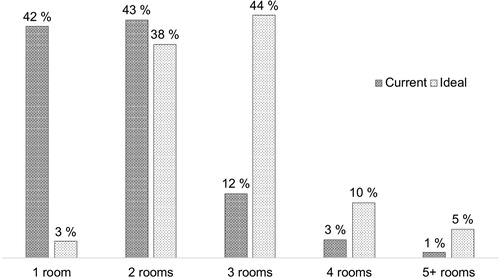
The ideal apartment size for both solo dwellers and other respondents (the reference group) is on average 20–21 m2 larger than their current apartments. The median value is 15 m2. A more detailed analysis shows that for solo dwellers with 20 m2 or less, the ideal apartment size (median) is 23 m2 larger than their current apartment. The corresponding median values are 16 m2 for apartments sized 30 to 35 m2, and 14 m2 for apartments sized 45 to 50 m2. When examining the solo respondents’ ideal apartment sizes, the mean value is 69 m2 and the median is 60 m2. Interestingly, these square metres represent the current apartment sizes of those solo respondents who stated that they do not need extra space (13%) (), thus confirming the findings describing the ideal apartment sizes. Since the solo respondents who are not in need of extra space have on average 2.5 rooms, the findings also indicate the retrofitting of solo-living into apartments originally designed for families as expected by Väisänen (Citation2015). All in all, the findings discussing apartment sizes demonstrate that decreasing household size and more space per occupier are interrelated (see Coolen & Ozaki, Citation2004).
As expected, there is a correlation between apartment size and income (see Dekker et al., Citation2011). Whereas the solo respondents with a net income of 2000 to 3499 euros have on average 50 m2, the apartments of solo respondents with a net income of 3500 to 5999 euros were on average 67.2 m2. Furthermore, the ideal apartment size increases along income level (). Solo respondents with the highest income are an exception, but these responses should be treated with caution due to their small number (n = 26). Additionally, the experienced shortage of space gradually decreases when moving towards a net income over 2000 euros (). The findings are in line with studies indicating that wealthier residents consume more space (Williams, Citation2009) and have higher expectations towards domestic space (Oseland & Raw, Citation1991).
Figure 2. Solo respondents’ current and ideal apartment size (m2) in relation to net income (EUR/month).
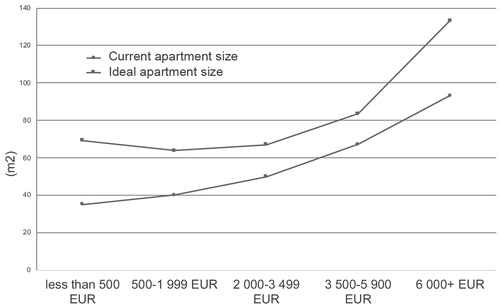
In addition to net income, age predicts the current apartment size, as the solo respondents under 30 years old have on average 1.3 rooms, which is smaller than those aged 60 to 69 years old with 2.4 rooms. The age-related difference may be explained by older respondents’ higher income and accumulated housing wealth. The findings are also expected to reflect a preference to age in place despite the shrinking household size (e.g. Abramsson & Andersson, Citation2016; Severinsen et al., Citation2016). Nevertheless, the ideal number of rooms for the youngest (20–29 years) is 2.7 and only 0.1 higher with the eldest (60–69 years). When all solo respondents are included, the ideal number of rooms only varies between 2.7 and 3.0.
Interestingly, differences appear when the apartment sizes are stated in square metres. Focussing again on both ends of the age spectrum, the ideal apartment size for the youngest solo respondents is on average 62.7 m2 and 9.2 m2 more than that for the oldest solo respondents (). These findings indicate that the number of rooms and square metres are not necessarily comparable when defining the ideal apartment types and sizes. On the other hand, the findings indicate that there may be a demand for apartments with different sizes in each apartment type category.
Table 1. Solo respondents’ current and ideal apartment sizes stated as number of rooms and square metres (m2).
The gap between the current and ideal apartment size is most notable with the youngest solo respondents, that is, 27.5 m2 (). Although this gap could be explained by their future plans including partners and families, the experienced shortage of space indicates that their apartments were perceived as being too small at the time of the survey. This notion is supported by the shortage of space that is experienced by 29% of the solo respondents under 30 years old, and 28% by solo respondents aged 30 to 39 years old. Only 8% of the oldest cohort experience the shortage of space in their home ().
When all the solo respondents are counted, the shortage of space is experienced by one fourth. The apartment type matters as indicated by 39% of those living in one-room apartments who stated that their homes are too small. Approximately half of both solo dwellers and members of other household types (the reference group) experience a shortage of space when the floor area per capita is 20 m2 or less. In contrast, less than 10% of the solo respondents with 50 m2 or more felt that their apartments were too small ().
Figure 5. The experienced shortage of space in relation to solo respondents’ current apartment size.
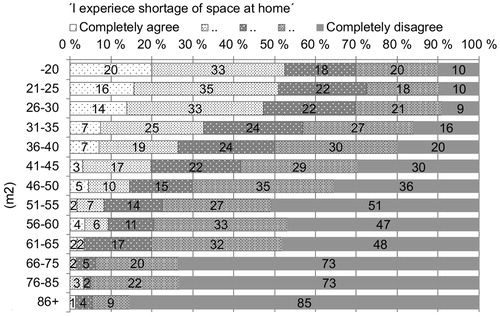
shows that the ratio between the experienced shortage of space and the apartment size is different between the solo respondents and reference group. While only 20% of the members of multi-person households experience the shortage of space when the floor area per capita is 26 to 30 m2, almost half of the solo respondents feel the same in a similar situation. This may be explained by the notion that all apartments contain certain communal spaces (kitchen, bathroom, hallway) which are not necessarily notably different in size in different apartment types and sizes. These observations support the notion that it is not reasonable to compare the dwelling density per capita between different household types simply because solo dwellers lack the opportunity to share domestic spaces (Juntto, Citation2008). In addition, it is important to recognize that in the case of solo-living, the dwelling density of 30 m2 or less signifies a one-room apartment that may feel small for reasons linked to the floor plans as discussed in the following section.
Insights into floorplans
One important difference between apartment types and floor plans is that apartment types based on the number of rooms are limited, while possible floor plans within each apartment type are numerous. This notion calls for a deeper understanding of the layout being defined as the most important characteristic when determining the quality of a housing unit (Özsoy & Gökmen, Citation2018). Hence, referring to the link between floor plans and kitchen types (Tervo & Lilius, Citation2017), this section discusses favored kitchen types as well as the use of ten extra square metres in relation to the respondents’ current homes.
Most solo respondents have an open plan kitchen (42%) with a majority (56%) naming it as their preferred kitchen type, thus indicating a preference for a layout in which the living, dining and kitchen spaces are combined. However, despite an open plan kitchen being perceived as better more often in comparison to a separate kitchen or kitchenette, its popularity is surprisingly low in relation to the fact that new Finnish housing stock provide no alternative to it. Thus, the respondents who prefer a separate kitchen with space for a dining table (38%) will either find their preferred kitchen type, and related floor plan, from older housing stock or settle for something else (see also Hasu, Citation2018) (). In light of these results, an open plan kitchen seems to be an example of dwelling feature that is considered eminent by architects and developers, but not necessarily valued by residents (Gao et al., Citation2013).
The most notable gap between the current and preferred kitchen type concerns the kitchenette as 24 per cent of solo respondents had this kitchen type, while only 6% favored it. The identified gap would be even wider if those respondents who currently have kitchens without a dining table were merged with those with kitchenettes. This can be explained by the vague difference between a kitchenette and a kitchen without a dining table ().
The spatial shortages related to kitchenettes are emphasized in the responses describing the use of extra ten square metres, as 47% of the solo respondents who currently have this kitchen type would like to have a larger kitchen. In the case of solo respondents with an open plan kitchen or a separate kitchen with a dining table, the figures are 20 and 16%, respectively.
Age partly explains the preferred kitchen type since over 60% of solo respondents aged 20 to 40 years old preferred an open plan kitchen. This may reflect the evolving role of the kitchen, which according to Ahn et al. (2015, p. 91) has transformed into a multipurpose space accommodating ‘social activities, household management, relaxation, and recreation’. Among solo respondents over 40 years old, an open plan kitchen and a kitchen with a dining table were almost equally popular. A preference for a kitchen with a dining table among older solo dwellers may be explained by the notion that this kitchen type can be found in older and larger apartments that are more often inhabited by older respondents. A preference for a kitchen separated from other living spaces may also be based on practical reasons (Eskelä, Citation2017) as well as ways of eating with guests (Ozaki, Citation2018), thus reflecting the often-dismissed social dimension of solo-living. In addition, the culture-related differences influence the preferred kitchen types (Findlay, Citation2011; Gao et al., Citation2013; Hofman et al., Citation2006), which in turn stresses the importance of understanding the context in which housing is studied.
A comparison between apartment types and experienced shortage of space highlights the significance of kitchen types. Whereas 36% of the solo respondents living in one-room apartments with an open plan kitchen experience a shortage of space, only 19% felt the same in one-room apartments containing a separate kitchen with a dining table. The corresponding figures in the case of a kitchenette is 48%, and 42% in the case of a kitchen without a table. Apartment sizes explain these differences to some extent, but not completely, as the average apartment size of a one-room apartment with a separate kitchen and table was 38 m2, and 32 m2 in case of a one-room apartment with an open plan kitchen. These findings are illustrated in , which point is to show how small difference in dwelling size has potential to influence on the experienced shortage of space. It should be noted that in real life, the implementation of this type of findings (i.e. floor plan design) happen in a specific context defined by a number of aspects such as dwelling type and typology as well as the characteristics of location and site.
Figure 8. Floor plan diagrams of one-room apartments that illustrate the difference between kitchen types (open plan kitchen and separate kitchen).
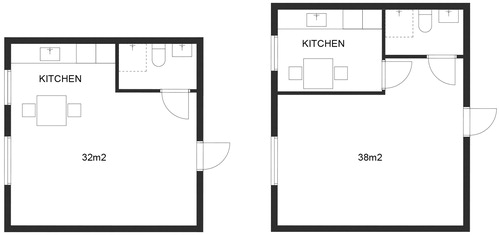
The significance of the kitchen type is emphasized by the findings stating that 44% of solo respondents who currently live in one-room apartments with a kitchenette would be interested in expanding their kitchens. In the case of two-room apartments and a kitchenette, the figure reaches 54%. The corresponding figures in the case of apartments with an open plan kitchen are 23 (one-room apartment) and 21 (two-room apartment) percent, and in the case of apartments with a separate kitchen, 18 and 22%, respectively.
The findings related to kitchen types and floor plans are encountered in a study focussing on the renovation of Finnish 1960–80s housing stock in which Kaasalainen & Huuhka (Citation2016a) note that a majority of apartments of this era are two-room apartments. Interestingly, the most typical type is a two-room apartment with a separate kitchen (type 2-1A) illustrated in (Kaasalainen & Huuhka, Citation2016a, p. 237; see also Kaasalainen & Huuhka, Citation2016b). Thus, it seems that the apartments originally designed for small families are suitable for solo dwellers only 30 to 50 years after their construction. This notion exemplifies the way a demographic trend leads housing related social and cultural transformation.
Figure 9. The most common apartment type in 1960–80s housing stock in Finland (According: Kaasalainen & Huuhka, Citation2016b, p. 279).
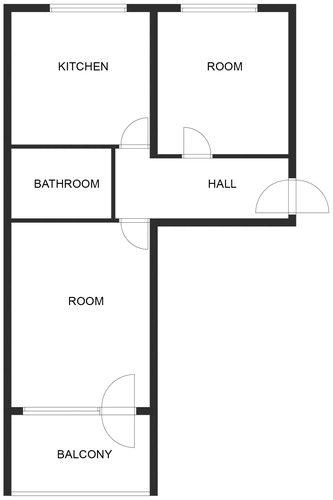
Regarding all domestic spaces, space is most often needed in walk-in closets regardless of the apartment type. This parallels previous Finnish studies reporting on a lack of storage space (Gibler & Tyvimaa, Citation2014; Gibler et al., Citation2014; Juntto et al., Citation2010). These findings may reflect decreasing apartment sizes often followed by tight storage spaces. It also seems that the design guidelines concerning storage space are outdated. In addition, at least 20% of the solo respondents identify bedrooms, kitchens, work spaces, and living rooms as spaces that would benefit from extra square metres ().
Whereas the lack of space regarding bedrooms can be explained by different reasons (see Jamieson & Simpson, Citation2013; Wulff et al., Citation2004), the idea of possessing a work space is interesting as it seems only reasonable to expect that a solo dweller has full control over the use of domestic space. If space dedicated to work is not based on a need to concentrate on something without being interrupted by other, it may reflect a need to draw a line between otherwise overlapping domestic spheres characterized by the multiuse of spaces (Williams, Citation2009, p. S89). Thus, key to solo dwellers’ domestic spatial needs seem to hide in the notion that they are surprisingly similar to the spatial needs of other household types. In addition, the findings suggest that spatial differentiation of the modern Functionalist dwelling (Saarikangas, Citation2002) is still valid and relevant not just for families that is was originally designed for. These notions call for a deeper understanding of the home when living alone. For instance, the value attached to several rooms is not necessarily privacy (see Coolen, Citation2008).
Discussion and conclusions
This article has examined solo dwellers’ spatial needs and the experienced shortage of space highlighting the perspective of urban housing design. The gap between the solo respondents’ current and ideal dwelling features indicate that many have homes that do not meet their needs and wants. This is particularly the case with those who live in one-room apartments. Nevertheless, based on a careful floor plan design that pays attention to the kitchen type as well as the amount of storage space and room sizes, it is possible to construct even one-room apartments in which the experienced shortage of space is less critical. However, the minimum floor area should be at least 30 m2 as almost half of the solo respondents experienced a shortage of space in the apartments smaller than that. Simultaneously, it is important to acknowledge that the aim should be to build at least 50 m2 apartments in order to overcome this shortage of space. Consequently, the findings do not support the construction of micro apartments.
The findings also show the link between apartment type, kitchen type, and floorplan. Since a separate kitchen sufficiently large to accommodate a dining table is perceived as a desirable kitchen type by almost 40% of solo respondents, the findings suggest that having this kitchen type as an option in the case of smaller apartment would improve housing supply and residential satisfaction.
The experienced shortage of space indicates that the norm defining overcrowded dwellings should be updated to include solo dwellers’ housing arrangements. The norm used by Eurostat (the Statistical Office of the European Communities) seems to align with this recommendation by stating that a sufficient number of rooms is achieved when a dwelling contains one room for the household and one room for each single person aged 18 or more (Eurostat, Citation2014). With solo dwellers, this makes a two-room apartment. Similarly, the established terminology should be revised ensuring it suits the case of people living alone, as the term ‘overcrowded’ denotes.
In addition, the correlation between solo respondents’ apartment size and income level call for more accurate argumentation when discussing the impacts of solo-living in the field of housing. The findings demonstrate that the union between small and affordable housing units has little to do with solo dwellers’ domestic spatial needs and everything to do with the makers and executors of housing policy that allow the housing markets to determine apartment sizes and prices. To conclude, solo dwellers’ housing issue is more complicated than their household size implies and as suggested by public discussion on affordability and micro apartments. This argument is supported by the ratio between the apartment size and experienced shortage of space that is different between solo respondents and multi-person households.
In order to develop field-specific methods for housing studies, this article has presented ways to construct a questionnaire enabling the exploration of dwelling features, the experienced shortage of space and their connection to floor plans. The advantage is that the method can be extended to cover other dwelling features. In addition, it can be applied in housing studies regardless of the country-specific context and household size. Simultaneously, the findings indicate a critical stance towards inquiries relying on the established apartment type categories when the aim has been to provide more fine-grained knowledge about dwelling features and floor plan variation within apartment types. On the other hand, the data collection method does not enable an exploration of the meanings related to dwelling features (see Coolen & Ozaki, Citation2004) or the quality of space. This type of knowledge would explain solo dwellers’ domestic spatial needs and further enable us to develop new forms of urban housing that may not be hindered by the modernist interpretation of the dwelling.
Data availability statement
The data that support the findings of this study are available from the corresponding author [Anne Tervo] upon reasonable request.
Acknowledgements
The authors would like to thank anonymous reviewers and Juho Saari, Tapio Kainulainen, Annastiina Nykänen, Anna-Sofia Berner, and Jenni Berlin for their contribution in collecting the research material and for providing an opportunity to conduct this study.
Disclosure statement
No potential conflict of interest was reported by the authors.
Additional information
Notes on contributors
Anne Tervo
Anne Tervo, MSc (Architecture) is a lecturer at the Department of Architecture, Aalto University. Her research interests include urban housing issues and housing preferences, which she examines from the perspective of design disciplines.
Jukka Hirvonen
Jukka Hirvonen, M. Soc. Sc (major sociology) is a researcher at the Urban Research and Statistics Unit of the City of Helsinki. He is specialized in quantitative housing research.
Notes
1 In Finland, apartment types are based on the number of ‘habitable rooms, i.e. excluding kitchen, bathroom, hall, walk-in closets etc.’ (Kaasalainen & Huuhka, Citation2016a, p. 232), and this definition is consistently used in this article. Hence, the Finnish apartment type definition differs from the generally used definition based on the number of bedrooms (see Williams, Citation2009, p. S84). For instance, a two-bedroom apartment is categorized as a three-room apartment in the Finnish context.
2 The Helsinki Metropolitan Area (HMA) consists of the cities of Helsinki, Espoo, Vantaa and Kauniainen. In 2017, the population was 1,120,422 million, divided into 562,017 households, out of which 249,175 were one-person households. The population in Finland is around 5.5 million (OSF, 2018b).
3 When both printed and digital version are included, the number of readers is 688,000 (Media Audit Finland, Citation2017) and the circulation is 325,000 (Media Audit Finland, 2018).
4 The Finnish term use used in the questionnaire is ihanteellinen that can be translated as ‘ideal’ or ‘optimal’.
References
- Abramsson, M. & Andersson, E. (2016) Changing preferences with ageing – housing choices and housing plans of older people, Housing, Theory and Society, 33, pp. 217–241.
- Ahn, M., Parrott, K.R., Beamish, J.O. & Emmel, J.E. (2008) Kitchen space planning in small-scale houses, Housing and Society, 35, pp. 83–96.
- Backman, K. (2015) Yksinasuvien helsinkiläisten asumispreferenssit, Master’s thesis, University of Helsinki, 2015.
- Baker, E. (2008) Improving outcomes of forced residential relocation: the development of an Australian tenants’ spatial decision support system, Urban Studies, 45, pp. 1712–1728.
- Boumeester, H.J.F.M. (2011) Traditional housing demand research, in: S. J. T. Jansen, H. C. C. H Coolen & R. W. Goetgeluk (Eds) The Measurement and Analysis of Housing Preferences and Choice, pp. 27–55 (Dordrecht: Springer).
- Buzar, S., Ogden, P.E. & Hall, R. (2005) Households matter: the quiet demography of urban transformation, Progress in Human Geography, 29, pp. 413–436.
- Chan, Y.-K. (1999) Density, crowding, and factors intervening in their relationship: evidence from a hyper-dense metropolis, Social Indicators Research, 48, pp. 103–124.
- City of Vantaa. (2018) Tilastokatsaus 3:2018, Asuntojen hinnat ja vuokrat Vantaalla 2017. Available at http://www.vantaa.fi/instancedata/prime_product_julkaisu/vantaa/embeds/vantaawwwstructure/138528_Tilastokatsaus_3_2018_Asuntojen_hinnat_ja_vuokrat_Vantaalla_2017.pdf (accessed 24 August 2018).
- Coolen, H. (2008) The meaning of dwelling features, conceptual and methodological issues. Available at https://books.bk.tudelft.nl/index.php/press/catalog/download/isbn.9781586039554/661/409-1?inline=1 (accessed 26th May, 2019).
- Coolen, H. & Ozaki, R. (2004) Culture, lifestyles and the meaning of dwelling. International Conference: Adequate & Affordable Housing for All. Available at https://pdfs.semanticscholar.org/43b0/c949eacf6378ffe3f08b0bbd205145bf7c92.pdf (accessed 26 May, 2019).
- Crosby, M. (2015) Space Standards for Homes (London: Royal Institute of British Architects). Available at https://www.architecture.com/-/media/gathercontent/space-standards-for-homes/additional-documents/homewisereport2015pdf.pdf (accessed 8 September 2018).
- Dekker, K., de Vos, S., Musterd, S. & van Kempen, R. (2011) Residential satisfaction in housing estates in European cities: a multi-level research approach, Housing Studies, 26, pp. 479–499.
- Eskelä, E. (2017) Housing pathways of skilled migrants: Indian professionals in Helsinki, Finland, Housing, Theory and Society, pp. 1.
- Eurostat. (2018) Rising proportion of single person households in the EU. Available at https://ec.europa.eu/eurostat/web/products-eurostat-news/-/DDN-20180706-1?inheritRedirect=true (accessed 24 August 2018).
- Eurostat (2014) Glossary: Overcrowding rate. Available at http://ec.europa.eu/eurostat/statistics-explained/index.php?title=Glossary:Overcrowding_rate (accessed 16 August 2018).
- Findlay, M. (2011) Social housing for cultural diversity, Australian Planner, 48, pp. 2–11.
- Finnish Social Services (2018) Housing benefits. Available at https://www.kela.fi/web/en/housing-benefits (accessed 24 August 2018).
- Gao, X., Asami, Y., Zhou, Y. & Ishikawa, T. (2013) Preferences for Floor Plans of Medium-Sized Apartments: A Survey Analysis in Beijing, China, Housing Studies, 28, pp. 429–452.
- Gibler, K. M., Tyvimaa, T. & Kananen, J. (2014) The relationship between the determinants of rental housing satisfaction and considering moving in Finland, Property Management, 32, pp. 104–124.
- Gibler, K. M. & Tyvimaa, T. (2014) The potential for consumer segmentation in the Finnish housing market, Journal of Consumer Affairs, 48, pp. 351–379. Summer 2014
- Hall, P. & Pfeiffer, U. (2000) Urban Future 21: A Global Agenda for Twenty-First Century Cities, Federal Ministry of Transport, Building and Housing of the Republic of Germany (London/New York: E & FN Spon).
- Hall, R., Ogden, P. E. & Hill, C. (1997) The pattern and structure of one-person households in England and Wales and France, International Journal of Population Geography, 3, pp. 161–181.
- Hasu, E. (2018) Housing decision-making process explained by third agers, Finland: ‘we didn’t want this, but we chose it’, Housing Studies, 33, pp. 837–819.
- Hasu, E., Tervo, A. & Hirvonen, J. (2017) Lifestyles and housing design: case Finnish townhouse, Nordic Journal of Architectural Research, 29, pp. 35–60.
- Helsingin seudun aluesarjat. (2017) Database. Available at http://www.aluesarjat.fi (accessed 29 August 2018).
- Henderson, S. R. (2009) Housing the single woman: The Frankfurt experiment. Full list of publications from School of Architecture. 5. Available at https://surface.syr.edu/cgi/viewcontent.cgi?article=1004&context=arc (accessed 24 August 2018).
- Hofman, E., Halman, J. I. M. & Ion, R. A. (2006) Variation in housing design: identifying customer preferences, Housing Studies, 21, pp. 929–943.
- Ilmonen, M. (2016) On housing preferences and residential choices, in: S. Gromark, M. Ilmonen, K. Paadam & E. Støa (Eds) Ways of Residing in Transformation. Interdisciplinary Perspectives, pp. 35–55 (Farnham: Ashgate).
- Jamieson, L. & Simpson, R. (2013) Living Alone: Globalization, Identity and Belonging (Basingstoke: Palgrave MacMillan).
- Jamieson, L., Wasoff, F. & Simpson, R. (2009) Solo living, demographic and family change: the need to know more about men, Sociological Research Online, 14, pp. 1.
- Jansen, S.J.T. (2012) What is the worth of values in guiding residential preferences and choices?, Journal of Housing and the Built Environment, 27, pp. 273–300.
- Junttila, N., Topalli, P.Z., Kainulainen, S. & Saari, J. (2016) The portrayal of lonely Finnish people, in: A. Rokach (Ed.) The Correlates of Loneliness, pp. 156–184 (Sharjah, UAE: Bentham Science Publishers).
- Juntto, A. (2008) Asumisen muutos ja tulevaisuus, Suomen ympäristö 33 (Helsinki: Edita Prima Oy).
- Juntto, A., Viita, A., Toivonen, S. & Koko-Kanerva, M. (2010) Vuokra-asunto Helsingissä sijoituksena ja kotina, Suomen ympäristö 29 (Helsinki: Edita Prima Oy).
- Kaasalainen, T. & Huuhka, S. (2016a) Homogenous homes of Finland: ‘standard’ flats in non-standardized blocks, Building Research & Information, 44, pp. 229–245.
- Kaasalainen, T. & Huuhka, S. (2016b) Accessibility improvement models for typical flats: mass-customizable design for individual circumstances, Journal of Housing for the Elderly, 30, pp. 271–294.
- Klinenberg, E. (2012) Going Solo: The Extraordinary Rise and Surprising Appeal of Living Alone (New York: The Penguin Press).
- Kontula, O. & Saari, J. (2016) Yksinäisyys parisuhteessa, in: J. Saari (Ed.) Yksinäisten Suomi, pp. 164–181 (Helsinki: Gaudeamus).
- Kortelainen, M. (2017) Uudet asunnot kutistuvat rajusti – Professori: “Vetovoimamme ei voi olla maailman pienimmät asunnot”, Helsingin Sanomat, June 12. Available at http://www.hs.fi/kaupunki/art-2000005250458.html (accessed 24 August 2018).
- Krokfors, K. (2016) Towards diverse and resilient housing production: on conditions of invention, in: S. Gromark, M. Ilmonen, K. Paadam & E. Støa (Eds) Ways of Residing in Transformation. Interdisciplinary Perspectives, pp. 199–219 (Farnham: Ashgate).
- Lu, M. (1999) Determinants of residential satisfaction: ordered logit vs. regression models, Growth and Change, 30, pp. 264–287.
- Media Audit Finland. (2017) KMT 2017 lukijamäärät ja kokonaistavoittavuus. Available at http://mediaauditfinland.fi/wp-content/uploads/2018/03/KMT2017lukijamaarat.pdf (accessed 2 August 2018).
- Media Audit Finland. (2018) LT ja JT tarkastustilasto 2017. Available at http://mediaauditfinland.fi/wp-content/uploads/2018/06/LTtilasto2017-1.pdf (accessed 2 August 2018).
- Ministry of the Environment of Finland. (2017) Ympäristöministeriön asetus asuin-, majoitus- ja työtiloista. Available at https://www.finlex.fi/fi/laki/alkup/2017/20171008 (accessed 24 August 2018).
- Ministry of Housing, Communities and Local Government. (2018) Housing benefit. Available at https://www.gov.uk/housing-benefit (accessed 8 September 2018).
- Morgan, M. & Cruickshank, H. (2014) Quantifying the extent of space shortages: English dwellings, Building Research & Information, 42, pp. 710–724.
- OSF. (2019) One-half of household-dwelling units live in dwellings completed after 1980. Available at https://www.stat.fi/til/asas/2018/asas_2018_2019-05-14_tie_001_en.html (accessed 6 June 2019).
- OSF (Official Statistics Finland). (2018a) Concepts, overcrowding. Available at http://www.stat.fi/meta/kas/ahda_asu_en.html (accessed 24 August 2018).
- OSF (Official Statistics Finland). (2018b) Household-dwelling units and dwelling population by number of persons, by number of rooms and type of building 2005–2017. Available at http://pxnet2.stat.fi/PXWeb/pxweb/en/StatFin/StatFin__asu__asas/statfin_asas_pxt_002.px/?rxid=225c0e7d-f603-4319-8630-697a199eb4ab (accessed 8 September 2018).
- Oksanen, K. (2018) Suomalaisia miniasuntoja kauhistellaan jo ulkomailla, sanoo kaupunkiprofessori Mari Vaattovaara – “Köyhille rakennetaan hellahuoneita”, Helsingin Sanomat August 20. Available at https://www.hs.fi/kaupunki/art-2000005796869.html (accessed 23 August 2018).
- Oseland, N. A. & Raw, G. J. (1991) Room size and adequacy of space in small homes, Building and Environment, 26, pp. 341–347.
- Ozaki, R. (2018) House design as a representation of values and lifestyles: the meaning of use of domestic space, in: R. G. Mira, D. L. Uzzell, J. E. Real & J. Romay (Eds) Housing, Space and Quality of Life, pp. 97–111 (New York: Routledge).
- Özsoy, A. & Gökmen, G. P. (2018) Space use, dwelling layout and housing quality: an example of low-cost housing in Istanbul, in: R. G. Mira, D. L. Uzzell, J. E. Real & J. Romay (Eds) Housing, Space and Quality of Life, pp. 17–28 (New York: Routledge).
- Paadam, K., Støa, E., Gromark, S. & Ilmonen, M. (2016) From housing to residing: conceptual considerations, in: S. Gromark, M. Ilmonen, K. Paadam & E. Støa (Eds) Ways of Residing in Transformation. Interdisciplinary Perspectives, pp. 3–19 (Farnham: Ashgate).
- Pajuriutta, S. (2018) Ajatuspaja Liberan toiminnanjohtaja Mikko Kiesiläinen syyttää miniasuntoja arvostelleen professori Vaattovaaran tilastotietoja virheellisiksi, Helsingin Sanomat, August 20. Available at https://www.hs.fi/kaupunki/art-2000005797682.html (accessed 23 August 2018).
- Rauniomaa, E. (2018) Rakentaminen Helsingissä 2017 sekä rakentamisen aikasarjoja, Tilastoja 2018, 6. Available at: https://www.hel.fi/hel2/tietokeskus/julkaisut/pdf/18_03_09_tilastoja_06_Rauniomaa.pdf (accessed 15 August 2018).
- Roberts-Hughes, R. (2011) Case for Space: The Size of England’s New Homes (London: Royal Institute of British Architects). Available at https://www.architecture.com/-/media/gathercontent/space-standards-for-homes/additional-documents/ribacaseforspace2011pdf.pdf (accessed 8 September 2018).
- Ronald, R., Druta, O. & Godzik, M. (2018) Japan’s urban singles: negotiating alternatives to family households and standard housing pathways, Urban Geography, 39, pp. 1018–1040.
- Saarikangas, K. (2002) Asunnon muodonmuutos: Puhtauden estetiikka ja sukupuoli modernissa arkkitehtuurissa (Helsinki: Suomalaisen kirjallisuuden seura).
- SATO. (2017) Asukastiedote. Available at https://www.sato.fi/fi/asukkaalle/asukastiedotteet/release631058 (accessed 24 August 2018).
- Salomaa, M. (2018) Kaupunkiprofessori väitti, että ulkomaillakin kauhistellaan Suomen ahdasta asumista – Syntyi pieni myrsky, mutta kuka lopulta oli oikeassa?, Helsingin Sanomat, August 21. Available in https://www.hs.fi/kaupunki/art-2000005798568.html (accessed 24 August 2018).
- Severinsen, C., Breheny, M. & Stephens, C. (2016) Ageing in unsuitable places, Housing Studies, 31, pp. 714–728.
- Silvennoinen, H. & Hirvonen, J. (2002) Koti kerrostalossa, asukkaiden arjen kokemuksia asumisestaan, Suomen ympäristö 575 (Helsinki: Edita Prima Oy).
- Strandell, A. (2017) Asukasbarometri 2016 — Kysely kaupunkimaisista asuinympäristöistä, Suomen ympäristö 19/2017. Available at https://helda.helsinki.fi/handle/10138/193009 (accessed 24 August 2018).
- Tervo, A. & Lilius, J. (2017) Urbaanien yksinasujien asuintilatoiveita, Yhdyskuntasuunnittelu, 55, pp. 11–32.
- Thorns, D. C. (2002) The Transformation of Urban Cities. Urban Theory and Urban Life (Basingstoke: Palgrave Macmillan).
- Väisänen, V. (2015) Tracing residential preferences of solo living. The Finnish perspective in an international context, Conference: Housing – a Critical Perspective. Available at http://architecturemps.com/wp-content/uploads/2015/10/vaisanen_virve_tracing-residential-preferences-of-sololiving-finnish-perspective-in-international-context.pdf (accessed 24 August 2018).
- Williams, K. (2009) Space per person in the UK: a review of densities, trends, experiences and optimum levels, Land Use Policy, 26, pp. S83–S92.
- Wulff, M., Healy, E. & Reynolds, M. (2004) Why don’t small households live in small dwellings? – disentangling planning dilemma, People and Place, 12, pp. 1, 57–70.
Appendix
What would be the ideal4 number of rooms needed by your household? Give the number of rooms excluding the kitchen.
What would be the ideal apartment size needed by your household?
What kitchen type do you consider to be the best? Multiple-choice question (separate kitchen that is sufficiently large to accommodate a dining table, open plan kitchen connected to the living room or other space and kitchenette).
If you would receive additional ten square meters in your current dwelling, how would you use them? Choose all the spaces in which you would use these extra square metres. Multiple-choice question (living room, kitchen, dining space, bedroom, work space, bathroom, sauna, hallway, walk-in closet or other storage space and I do not need extra space.
I experience a shortage of space at home. Five-level scale ranging from completely agree (value 1) to completely disagree (value 5).

